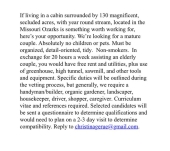Greetings Permies,
I have a natural building work exchange opportunity in the heart of the Ozark bioregion that I'd like to share with you. I am building a straw bale house in south central Missouri on my 18 acre homestead and am looking for some motivated humans who would love to learn these skills in exchange for helping me.
We are currently placing bales on the second story and will continue plastering into the next month until frosts slow the work down. For the next month, I am looking for a few individuals who would like to come stay on my land (at least one week- up to one month preferred) and skill build in exchange for helping me get the walls up on my house. I am also open to folks who want to come out for a day or weekend so reach out! I host work parties often and have quite a bit of experience in this type of building.
Within this work exchange opportunity, you will learn how to build a straw bale wall, including cutting, reshaping and retying bales. I will also share the basics of preparing native clay for slip and earthen plaster. You will gain experience in creating and applying clay slip and earthen plaster.
I have ample camping available, an outdoor kitchen, a well and outdoor shower, a slip straw sauna (pictured below) for community sweats, a spring fed creek, and am close to some local lakes, rivers and woodland recreation areas. We established this permaculture homestead in 2016 and have extensive perennial plantings, organic gardens, a composting toilet, and other natural buildings on site. I am off grid with a solar system. 15 minutes from the closest small town and 45 from a few larger towns with more commerce.
If you're interested, reach out to me directly and I can provide more details, including my website and social media, and answer any questions.
Thanks!
Wren









